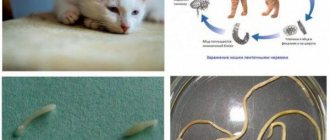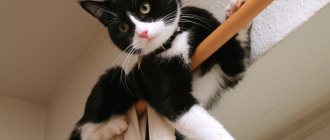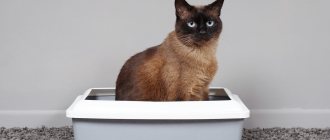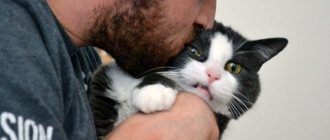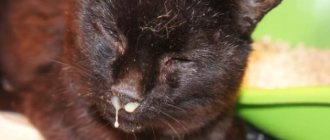The process of licking their fur is a real ritual for domestic cats. These animals are clean by nature, so grooming is an integral part of grooming.
In addition to cleanliness, licking the fur improves thermoregulation. When a pet runs a wet tongue over the fur, hydration occurs and, accordingly, cooling occurs against the background of the process of moisture evaporation. At the same time, the body temperature decreases.
Some owners note that the cat begins to actively lick itself after being stroked. This is due to the return of its natural smell. The presence of unnatural odors on the animal's fur makes it worry. This is due to the fact that cats are real predators, so the presence of a foreign smell can attract the enemy.
Normal or pathological?
Normal cat hygiene is licking all fur several times a day, and briefly washing after contact with other animals or people. At the same time, the cat behaves calmly and relaxed, she is focused on the cleanliness of her coat.
A disease should be suspected if any movement of the animal is accompanied by licking of fur. At the same time, the cat behaves restlessly, is irritated or feels discomfort. This behavior may indicate itching or pain that the animal is suffering.
If a cat constantly licks itself, the cause of this phenomenon is:
- Parasites;
- Allergic reaction;
- Lichen;
- Dermatitis;
- Endocrine disorders;
In this case, you can detect accompanying symptoms of diseases - scratching of the epidermis, the formation of erosions and wounds, peeling of the skin.
Why do cats groom themselves?
Cats groom themselves not only to maintain cleanliness, but also for a number of other health reasons:
- To regulate body temperature.
- To keep your coat clean and smooth by distributing the skin's natural oils.
- To stimulate blood circulation.
- To cool down through the evaporation of saliva.
- To get rid of parasites, infections and allergies.
- To prevent hairballs.
- Displaced behavior: If a cat feels embarrassed, anxious, or as if she is in a dangerous situation, she will lick herself to calm herself down.
Symptoms of the presence of parasites
Animals show increased attention to their own hygiene in the presence of parasites - fleas or ticks.
At the same time, the cat is constantly itching, shaking itself off and licking itself. You can suspect parasites by carefully examining the animal's fur. If no fleas are found, it is recommended to inspect the coat again, paying attention to the areas behind the ears and on the neck. A possible cause of discomfort may be nits, which can be difficult to detect with a quick examination. Excessive peeling of the skin in the absence of visible parasites may indicate a mite.
As a rule, with such diseases, the animal constantly tries to gnaw something out of the fur, simultaneously licking different parts of the body. Treatment is carried out using special anti-parasitic drops.
We recommend the article: Symptoms of cystitis in a cat: treatment and prevention
Is it safe for a dog to lick its face?
If you are not immunocompromised or in a vulnerable age group, dog saliva does not pose a particular risk to your health. Dog saliva contains bacteria, but it does not pose a significant risk to healthy people. Although it's unlikely, dogs can transmit worm eggs to you in their saliva through direct contact. Therefore you need to know about this.
However, do not allow your dog to lick your face if you are sick, have a weakened immune system, or are in a vulnerable age group. If you have a weakened immune system, this may mean that bacteria from your dog's saliva can negatively affect you since your body is already weakened. The same goes for very young or very old people, as they do not have a strong enough immune system to fight off certain types of bacteria. Again, if you are sick, your immune system will be weaker and this may make you more susceptible to different types of bacteria.
It can also be a problem if your dog licks your wound, as this is an entry point for bacteria. This can lead to infection of the wound, which will require the use of antibiotics.
Ringworm and fungi
Ringworm in animals appears as small patches of baldness. In this case, scabs or erosion may be present on the skin, but this depends on the causative agent of the disease.
Quite often, the reason that an animal licks itself more often than usual is a fungal infection. It is impossible to identify the fungus without special equipment, but dry skin and flaking can help you suspect the disease. It is these symptoms that cause discomfort to the cat, in response to which he constantly licks himself, itches and chews his fur.
Upon careful examination, you will notice the following signs on the skin:
- Severe dryness;
- Change in color (pale skin or redness);
- Separation of dense grayish scales;
- Hair thinning;
These symptoms are characteristic of various fungal infections, including lichen. In this case, hair loss can be caused both by the characteristics of the disease and by the actions of the animal itself. Often, in response to itching, cats gnaw out islands of fur, trying to reach the skin with their claws.
Treatment of fungal infections is carried out with the help of antimycotic drugs. Shampoos and ointments used to treat people are usually prescribed - Nizoral, Ketoconazole, Clotrimazole.
Causes
There are five main reasons why a dog may lick its owner's face. The most famous of these is licking for affection or also known as kissing your owner. Here we will explain how these goals influence this action.
- Attachment. The most common reason why a dog licks its face is to show affection. Mother dogs will lick their puppies to clean them from birth until they grow. This action can be seen as a form of withdrawal. It is often used between dogs to show each other trust and care. Essentially, it can be interpreted as one dog caring for or looking after another.
- Submission . A dog licking your face can be a sign of submissiveness to you, strangers and other dogs. If you have a particularly nervous dog, he may lick his owner's face frequently to demonstrate his submissiveness. The pack theory has been disproved in dogs and wild wolves. However, this does not mean that levels of dominance and submission are completely eliminated in dogs. It all depends on the household and circumstances. Although their view of us will always be more like a family than a hierarchical pack.
- Taste . This may seem obvious, but quite often a dog may lick your face purely because of your good taste. This can be applied to two different basic situations. After you've exercised or just stuck your hands in something the dog finds tasty and wiped your face. You sweat during and after your workout. It's pretty gross, but dogs like the taste of sweat because it's salty. So if you find your dog licking your face on a hot day or after a workout, this is the most likely reason.
- Care . Just as mother dogs will lick their puppies to remove dirt or even amniotic fluid after birth, dogs will lick you to clean you. They do this by removing what they consider external debris or dirt. You may notice that they look at your body or clothes first and smell them. Often they will assess the situation to see if they feel you need to be groomed. Then, if they feel you need grooming, they will proceed to lick the area.
- Indicating meal times . Almost every dog loves treats and mealtimes. Not many owners know that your dog licking you can be a sign that they know it's time to eat soon. Dogs have internal clocks similar to us. This is one of the reasons that routine is so important to them.
© shutterstock
Allergies as a cause of unusual behavior
Food allergies always manifest themselves as crusts, wounds and erosions on the animal’s face. Sometimes cats develop allergic dermatitis in response to household irritants. Quite often, itching and flaking of the skin appear after:
- Applying a new shampoo while bathing the cat;
- Removing fleas with special solutions;
- Contact of household chemicals with animal fur;
The symptoms of an allergy are in many ways similar to the signs of a fungus on the skin - the cat constantly licks itself and itches. As a rule, the hypersensitivity reaction passes quickly, you just need to protect the animal from contact with the irritant.
Pathological reasons for a cat to lick itself until it becomes bald
Constant licking of fur is not dangerous for a cat, unless it becomes permanent. If the owner notices that bald patches or alopecia are beginning to form on the pet’s skin, it is necessary to pay close attention to this.
As a result, this can lead to the formation of serious inflammations on the skin and bald patches. Wounds, ulcers and the formation of purulent exudate may occur. This is due to the fact that pathogenic bacterial microflora entered the wounds, causing the progression of the infection. It is necessary to close the wound surface and seek help from a veterinarian.
Self-treatment of the wound with antiseptics and application of antibacterial ointments may not produce results or may cause complications.
During licking, cats swallow some of the hairs, which subsequently enter the digestive tract. It is known that wool does not disintegrate under the influence of acids produced by the stomach and intestines. The resulting hairballs accumulate to form large trichobezoars.
In the absence of their natural elimination from the body, the possibility of developing intestinal obstruction cannot be ruled out. The pet becomes lethargic, refuses food, and there is a lack of bowel movements.
Areas of baldness on the stomach or other part of the animal’s body are formed not only as a result of increased hygiene. The appearance of alopecia is also provoked by severe itching, which prevents the animal from calmly caring for itself.
Severe itching and discomfort in cats occur against the background of serious allergic reactions as a result of exposure to various factors.
An allergy, manifested by itching on the skin of a cat, can be food (the presence of a foreign protein in the food), feeding the cat with products from the human table.
An allergic reaction occurs in some sensitive animals to medicinal and cosmetic products for the care of cat fur.
The appearance of bald patches as a result of careful licking may be a signal to the owner that the animal’s emotional state is unstable. When experiencing stress, a cat begins to withdraw into itself, since by nature these predators are loners.
Any, even the most minor, change in a cat’s normal lifestyle can cause serious stress. Factors such as a change of place of residence, a long trip by transport, an acclimatization period, long-term illnesses, and chronic inflammatory processes can frighten or make a pet feel stressed.
Help from the owner - creating comfortable living conditions, increased care and attention to the pet.
Scientists also note that among the pathological factors that provoke frequent licking in a cat is the restriction of the freedom of movement of this freedom-loving creature.
Dermatitis in cats
Itching and pain of the skin can be caused by dermatitis.
This disease is caused by an immune disorder and the activation of opportunistic microorganisms on the animal's skin. Dermatitis is always accompanied by inflammation of the epidermis. With moderate inflammation, the animal becomes restless, itching, and the cat constantly licks its fur. Suspecting the disease at this stage is quite problematic.
We recommend the article: What causes red spots in a cat's ears?
In most cases, dermatitis is accompanied by visible symptoms - severe peeling of the skin, the formation of rashes, wounds and erosions. The rashes are most often localized on the pet's face, near the ears and on the neck.
Treatment is carried out using external agents, but only after identifying the pathogen.
Cat licks fur after sterilization
If you've ever had surgery, you're probably familiar with that itchy feeling of stitches healing. Sterilization is a serious intervention in the functioning of the body, requiring a long recovery. A cat, unlike a person, is not able to understand that the stitches cannot be touched, so it begins to lick and scratch them.
The problem can only be solved by wearing a protective (Elizabethan) collar, which is a cone-shaped device. It restricts the cat's movements and prevents her from licking herself. After surgery, the pet must wear a collar for at least 10 days. This time is enough for the seams to heal and the animal cannot tear them.
First steps to solving the problem
If you notice that your pet is not licking itself for hygienic purposes, then first of all check it for the presence of fleas and other parasites. Do this in a room with good lighting and use a magnifying glass if possible. It is better to examine the cat immediately after washing, while the fur is still wet.
Remember what has changed in your apartment recently. Perhaps you started feeding your cat a new brand of food or planted an exotic houseplant. This will help determine if your pet has allergies.
When a cat scratches itself until it bleeds, licks the same place, shakes its head and does not allow itself to be picked up, it almost certainly has some kind of skin disease. In this case, you need to take her to the veterinarian, and upon return, isolate her from other pets, if any. You should not self-medicate and smear the affected areas with ointments of unknown origin. Use only those medications prescribed by a specialist.
At a veterinary clinic, the diagnosis is made based on a series of tests, including scrapings. This is necessary to identify viruses, fungal spores or subcutaneous mites. If the doctor suspects that the disease is caused by a malfunction of the endocrine system, he will prescribe an additional examination.
Treatment
The course of treatment prescribed by a veterinarian is aimed at eliminating the cause of the disease, not the itching. The list of necessary medications varies depending on the diagnosis, as well as the weight and age of the animal. For allergies, it may contain antihistamines.
Be prepared for the fact that you will have to review your pet's diet and adjust it in accordance with the requirements of the cat's body. If the disease is caused by subcutaneous mites, dry cleaning or replacement of the bed on which the cat slept is required. You need to do the same with his toys.
How to prevent itching
Sometimes itching is only a consequence of improper care of the animal. Some people believe that it is enough for a cat to lick itself to get its fur in order. In fact, it is necessary to regularly wash the animal with special gentle shampoos. After water treatments, clean your pet's ears. Use a comb or brush to untangle and smooth the hairs. It is especially necessary to do this during shedding so that the cat does not swallow the fallen hair.
Wash the bed and wash the cat's bowl in a timely manner. Do wet cleaning in the house regularly. During your walk, do not allow your pet to have uncontrolled contact with street animals, and do not allow them to approach you.
You will have to be patient to rid your cat of the habit of licking itself. Regardless of what provoked this behavior, you cannot leave things to chance and not care about the health of your pet.
The most common diseases in cats:
Asthma Chronic renal failure Cancer Diabetes Leukemia Urolithiasis Liver amyloidosis Hyperthyroidism Immunodeficiency virus Hepatic lipidosis Infectious peritonitis Hypertrophic cardiomyopathy Ringworm Liver diseases
Before you take your cat home, you should make sure it is healthy. Every year your cat needs a veterinary examination. The earlier you detect a disease, the easier it is to treat.
There are diseases that can be transmitted from cats to humans, but this does not happen often. These diseases are: Cat scratch fever Rabies Ringworm Toxoplasmosis
If your cat has the following symptoms, this means that the pet is sick: the cat lies with its paws tucked in for a long time; lethargy (accompanies almost all diseases in cats); the cat’s body is hot (probably fever); poor appetite or refusal to eat; loss of body weight, even if The cat has a normal appetite The cat drinks much more than usual Very frequent or large amounts of urination Straining when urinating (take the cat to the vet immediately) Persistent sneezing Hoarseness, choking or difficulty breathing The cat is coughing, gagging diarrhea or blood in the stool vomiting convulsions, seizures , trembling, twitching and disorientation, the animal is bleeding, in addition to scratches, a bump or swelling, the animal is swaying, limping.
Skin diseases that are easiest to diagnose are the purr. The most common types are wet and dry eczema, tangles, and trichomes. If your cat is covered in red spots, itches all the time and has hair falling out, it most likely has dry eczema. But wet eczema is characterized by the appearance of weeping red spots, and this disease occurs due to allergies. Matted hair or tangles, this disease is typical mainly for long-haired cat breeds.
Common infectious diseases in cats are colds, sore throat, and bronchitis. The symptoms of these diseases in cats are very similar to those in humans. The disease is accompanied by a runny nose, cough, indigestion and fever. For example, bronchitis usually affects weakened and old animals. Bronchitis is an inflammation of the lining of the bronchi in cats, and can be acute or chronic. For effective treatment, first of all, you need to provide the animal with good nutrition and a warm place, because feline bronchitis occurs with the same symptoms as in humans (chills, increased body temperature, fever). For treatment, you need to use expectorants and disinfectants, medications that dilate the bronchi, antibiotics, antimicrobial agents, and inhalations.
- Symptoms of cat diseases
Symptoms of cat diseases- Symptoms of cat diseases
